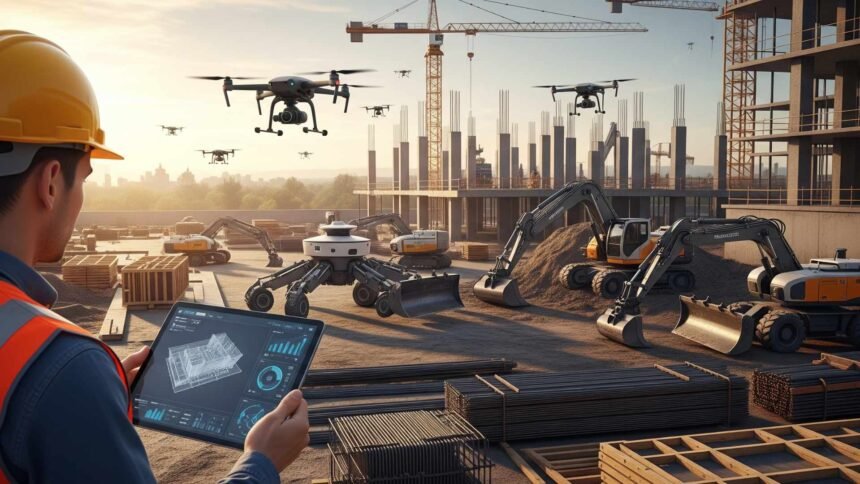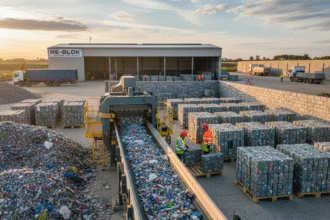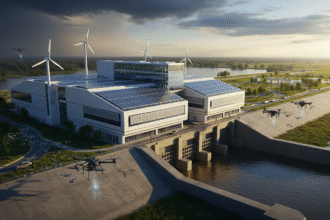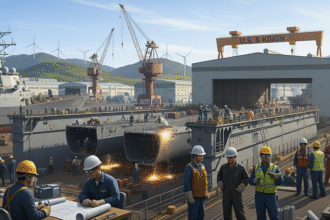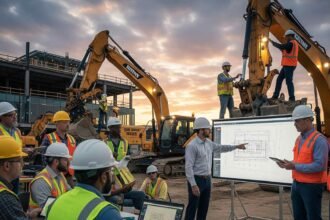AI in a construction company’s toolbox
Construction companies face tight deadlines, rising costs, and labor shortages every day. Yet, many still rely on traditional tools while a technological revolution unfolds around them. Artificial intelligence (AI) promises to reshape the industry, but is it part of your operations yet? Recent reports show a surge in AI adoption, with early users reaping significant rewards.
The Current State of AI Adoption in Construction
Construction firms increasingly embrace AI, driven by market pressures and technological advances. A 2025 report from Houzz reveals that 34% of U.S. construction and design professionals now use AI tools. This marks a notable rise, especially among larger firms with over 10 employees, where adoption reaches 64% for construction companies. Another study by RSM US and Big Village reports even higher figures: 94% of surveyed firms in the U.S. and Canada use some form of AI, including 95% experimenting with generative AI.
Experts predict explosive growth. The AI in the construction market, valued at $3.99 billion in 2024, will likely expand to $11.85 billion by 2029, growing at a compound annual rate of 24.31%. This boom stems from increasing spending and education on AI, creating what industry insiders call an “arms race” among builders. Contractors feel the pressure to adapt or fall behind, as competitors leverage AI for efficiency gains.
News from early 2025 underscores this shift. In January, Construction Dive highlighted how AI education surges, with firms investing more to stay competitive. By July, Builder Magazine noted that early adopters save an average of three hours per week per user, translating to $108,000 in annual productivity gains per business. Two-thirds of professionals believe AI will transform the sector within five years. Yet, adoption varies: smaller firms lag, often due to resource constraints.
Unlocking the Benefits of AI
AI delivers tangible advantages that smart companies harness. It streamlines administrative tasks, which 62% of users prioritize, including report generation and data analysis. In project management, AI optimizes schedules and resources, reducing delays. For instance, tools like Autodesk’s Construction IQ analyze risks in real time, helping teams make proactive decisions.
Safety improvements stand out. AI monitors sites via computer vision, detecting hazards and ensuring compliance to prevent accidents. Predictive maintenance, another key use, forecasts equipment failures, cutting downtime and costs. Supply chain optimization uses AI to predict material needs and prices, enhancing cash flow.
Design and planning benefit too. Generative AI creates innovative designs faster, integrating with building information modeling (BIM) for efficient workflows. Sustainability gains traction as AI tracks energy use and minimizes waste. Overall, 89% of firms report positive impacts from generative AI, with users noting moderate to significant workflow improvements.
Take the labor shortage: AI automates repetitive jobs, freeing workers for complex tasks and attracting tech-savvy talent. As one expert puts it, AI “empowers field teams” by making tools more accessible. These benefits explain why 78% of leaders see AI enhancing the industry.
Overcoming the Hurdles
Despite the hype, barriers persist. A “maturity gap” plagues the sector: 59% of firms feel unprepared for full AI integration, citing a lack of expertise and data quality. Training gaps are stark—94% of designers and 92% of contractors receive no formal AI education.
Challenges include data privacy, security, and budget issues, with 36% struggling with data quality and 32% facing cost constraints. Implementation often proves harder than expected for 61% of adopters. Regulatory concerns and cybersecurity risks add complexity.
Firms address these by partnering with tech providers and outsourcing. Eighty-two percent allocate AI budgets, with 90% planning increases. Experts recommend starting small, focusing on quick wins like chatbots for queries or AI for drawing reviews. Building a roadmap for people, processes, data, and technology helps bridge the gap.
Real-World Success Stories
Companies lead the way with AI. Trunk Tools, featured in Construction Dive, develops AI for builders, aiding in rapid advancements. ALICE Technologies uses AI for project timelines, streamlining resource allocation.
Bouygues UK integrates AI for energy monitoring and safety via computer vision. ICON employs AI chatbots for data interaction, automating reviews. These examples show how AI turns challenges into opportunities, with firms reporting reduced costs and improved efficiency.
In March 2025, news highlighted AI’s role in AEC workflows, reducing expenses and boosting outcomes. Deloitte’s report notes construction businesses adopt an average of 6.2 technologies, up 20% from last year, including AI.
Looking Ahead: The Future of AI in Construction
AI will evolve into an “unseen necessity,” embedded in tools for suggestions and automation. Trends point to autonomous equipment, like drones and robots, combined with AI for smarter sites. Generative AI will speed up designs, while predictive analytics prevents issues.
By 2025’s end, experts foresee wider collaboration via AI, with immersive tech like XR enhancing preconstruction. However, success depends on addressing training and data issues. As investments boom, companies that integrate AI early will gain edge in efficiency and innovation.
AI no longer hides in the shadows—it’s a vital tool reshaping construction. If your company hasn’t added it to the toolbox, now’s the time. With proven savings, safety boosts, and market growth, embracing AI ensures you stay ahead in this competitive field. The question remains: Will you lead the change or catch up later?


